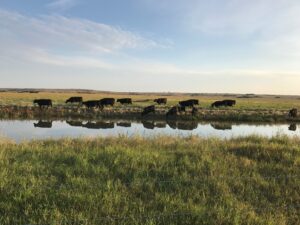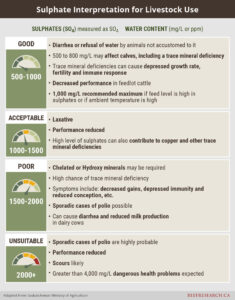Test Stock Water & Reduce Worry
When stock water appears abundant and water quality has been consistent in previous years, it’s easy to focus on other things but don’t overlook water testing. Poor quality stock water can lead to reproductive inefficiency, poor gains, disease and in extreme circumstances, death. Even when water supplies appear abundant, stock water may contain high levels of sodium, sulphates or other compounds that lead to toxicity.
Water quality can be especially variable in surface water sources, such as dugouts, ponds or dams, and weather doesn’t necessarily need to be hot and dry to warrant regular testing. Precipitation levels in the previous years, groundwater recharge, runoff conditions, evaporation levels and adjacent land use can all impact water quality in both the short- and long-term.
It’s also important to monitor well water conditions. Quality in well water can change quickly, even if wells have had suitable water in the past.
Take the Test
In a Bov-Innovation video presentation featured during the 2020 Canadian Beef Industry Conference, producer Carla Hicks of DC Land and Cattle near Mortlach, Saskatchewan, shared her perspective on why water testing is essential on their farm (watch the video at 10:43).
“It’s something we’ve always kind of paid attention to,” says Hicks, who adds that they live in an area where they’ve experienced water quality issues and now they regularly test dugouts. Hicks says they typically test water about once a month in the summer time, and a couple times throughout the winter on their winter water sources as well.Hicks says they will move cattle to a different pasture to alternate water, or even haul water if quality deteriorates. “We’re kind of limited into the water sources we have available so it’s kind of really just making sure we don’t have a surprise issue and that we can always come up with something if we have a water problem,” she explains.
Hicks describes a time when their cattle herd experienced problems drinking out of a dugout with elevated sulphate levels. “We ended up with cows coming down with polio and we also had some issues with nursing calves so that was really a light bulb moment for us,” she says.
“The year that we had the really bad water, we were aware of what was happening because of the water testing we were doing, so we were able to implement extra supplementation,” Hicks says. She adds that while breeding was delayed that year, their cows were still bred because they were able to intervene in time and prevent a total disaster, thanks to regular water testing.
Catherine Lang with the Saskatchewan Ministry of Agriculture, explains how to collect and perform a water sample (fast forward to 13:45):
- To obtain a water sample, collect water in a clean, 1 litre container. It can be a designated sample container or even a glass jar or pop bottle that has been thoroughly cleaned.
- Collect a sample that is representative of what the cattle are actually drinking. This may mean reaching in two to three feet or even using a retractable stick to safely get a sample. (Skip ahead to 14:15 for a demonstration).
- Water samples are typically assessed for electrical conductivity which helps measure total dissolved solids (TDS) which provides an indication of sodium and sulphates. (See how conductivity is tested at 15:33).
Stock Water and Stockmanship
Every cattle farm is different. Some herds drink out of troughs their entire lives while other cattle are reared on the range, learning to walk a mile or more to water once a day out of a dugout or dam. When you move cattle to a new field, it is important to “settle” cattle on the best water source in the field. It may take extra time and effort to herd cattle to their water source, but producers can’t assume cattle will find stock water on their own. This is especially important in large fields with multiple water sources that may include smaller potholes that can dry up as the weeks go by.
Thirsty cattle can become confused and refuse to leave the only water source that is familiar to them, even if it has dried up and there is better water elsewhere in the field. Cattle can become stuck or bogged in the mud, making retrieval difficult and time consuming. Cows can also get muddy udders, causing nursing problems.
Stock Water Tips
- Implement a water system, such as a solar- or wind-powered pump, to help extend the length of a dwindling stock water source as well as improve water quality and increase animal gains.
- Work with your local agricultural extension office to obtain accurate test results, as well as learn about potential water development or testing rebates.
- Test water prior to moving cattle to a new pasture. Even if there is an abundance of water present, don’t assume the water is good quality.
- If cow-calf pairs are expected to drink water out of troughs, ensure that calves are able to reach the trough as well.
- If cattle are watering solely on a water system or pipeline with no access to a back-up water source in case of failure, ensure those cattle are monitored daily especially during the summer heat.
- Blue-green algae (i.e. cyanobacteria) can also cause toxicity. Monitor for an “oily” sheen, or something resembling spilled paint on the dugout surface, or “grass clippings” in the water. Both are signs of cyanobacteria which can cause toxicity.
Water Testing Locations:
- British Columbia, Alberta, Saskatchewan, Manitoba, and Ontario (Saskatchewan Agriculture)
- Nova Scotia (Nova Scotia Government)
- Prince Edward Island (PEI Government)
Learn More:
- Water Systems for Beef Cattle (BCRC Webpage)
- Water Systems Calculator (BCRC Calculator)
- What’s in Your (Stock) Water (BCRC Blog Post)
- What’s in Your Water? Water Quality and the Economics of Pump Systems (BCRC Webinar)
- Blue-Green Algae (Cyanobacteria) (Saskatchewan Agriculture)
Click here to subscribe to the BCRC Blog and receive email notifications when new content is posted.
The sharing or reprinting of BCRC Blog articles is welcome and encouraged. Please provide acknowledgement to the Beef Cattle Research Council, list the website address, www.BeefResearch.ca, and let us know you chose to share the article by emailing us at info@beefresearch.ca.
We welcome your questions, comments and suggestions. Contact us directly or generate public discussion by posting your thoughts below.


